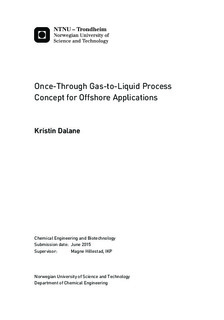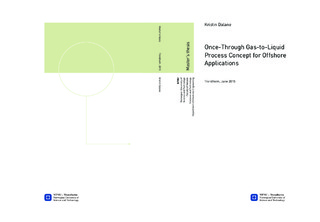| dc.description.abstract | The worlds energy demand is increasing, and at the same time the amount of easily accessible oil is reduced. Associated gas for most off-shore applications are flared or injected in the reservoir due to transportation challenges. A gas-to-liquid (GTL) process for offshore applications could be a solution to make valuable products of the associated and remote natural gas resources.
GTL is a process that converts carbon based feedstock to more valuable liquid products. One of the main technologies used are the Fischer-Tropsch synthesis.
A new process design for a GTL process for off-shore applications are proposed. The syngas is produced with an autothermal reformer (ATR) with enriched air as oxidant. The process design is a once-through, to prevent accumulation of nitrogen. Once-through means that no unconverted syngas is recycled in the process. In order to maximize the conversion and production of higher hydrocarbon the Fischer-Tropsch synthesis are staged. Three multitubular fixed bed stages are used with product separation and hydrogen added between each step. Two Fischer-Tropsch reactors in parallel are used for the two first reactor stages. The hydrogen is produced by steam methane reforming in a heat exchanged reformer, where heat needed for reaction is provided from the hot outlet stream from the ATR. The tail gas in the process is used for power production in a gas turbine. The hot effluent gas from the gas turbine is used for pre-heating of the natural gas.
The process design is modelled and optimized with the use of Aspen HYSYS V8.6, with some use of Aspen Custom Modeler and MATLAB programming. The kinetic model used for the Fischer-Trospch reactors are proposed by Todic et al., with a product distribution model proposed by Hillestad.
There are several parameters in the process that could be optimized. Optimizing in this master thesis are focused on obtaining the maximum production of C5+, which means hydrocarbons with five carbon atoms or more. The optimal distribution of the natural gas in the process was found to be 90% to the autothermal reformer and 10% to the heat exchanged reformer.
With a natural gas feed amount of 120 MMSCF or 6,000 kmole/h the total production in the process are found to be 53.9 tonne/h or approximately 10,000 bbl/day. The carbon efficiency in the process is 57% and the energy efficiency is 45%. The process is self-supported with utilities and produces 36.4 MW of external power and 501 tonne/h of medium pressure steam. The total investments cost for the plant is estimated to 543.7 million$. | |

